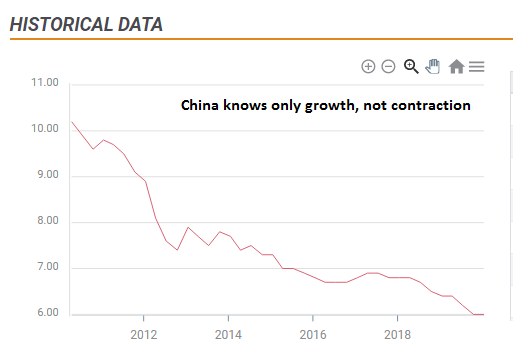- Economists expect China to report the economy squeezed by 6% yearly in Q1 2020.
- The world's second-largest economy is the first to provide coronavirus-related GDP figures.
- Markets' reaction to Chinese trade figures shows the figures matter, regardless of doubts.
Well before the world knew where Wuhan is on the map, investors suspected statistics from China – especially when it comes to Gross Domestic Product. Nevertheless, the publication early on April 17 will likely be watched closely and impact all markets.
Reasons to be doubtful
Li Keqiang, then the Party Committee Secretary of Liaoning, told the US ambassador that GDP figures in his region were unreliable. That was in 2007 before Keqiang was promoted to Prime Minister. He offered alternative measures for assessing the size of the economy, such as electricity consumption, railway cargo, and other indicators that The Economist later turned it into the Keqiang index.
Governors and the state had reasons to report rosier figures than reality suggested. Moreover, Beijing's targets were normally met with incredible precision, also raising eyebrows. China's orchestration of a "smooth landing" from quick growth seemed to be smoothed by official statistics.
Moreover, China compiles and publishes GDP data less than three weeks after the related quarter concludes and refrains from revisions. Western countries need more time and modify the data as time goes by.
COVID-19 also added to doubts. Authorities initially sought to play down the cluster of pneumonia cases in Wuhan, punishing whistleblower doctors before changing its approach. The number of mortalities from the disease is also seen as too low by many, amid anecdotal reports of crematoriums working non-stop in Hubei province, where Wuhan is situated.
Why it matters to markets
Having said all that, why should traders await China's first-quarter growth figures? The main reason is the virus. So far, higher frequency data has provided up-to-date – yet partial – data about COVID-19's damage. China will be the first major economy to provide an overview of the impact on the economy. The world's second-largest economy was also the first to suffer from coronavirus and lockdown citizens.
Another reason to expect market movement is the impact of the figures on policy in China and in other places. If Beijing publishes upbeat figures, it may provide for other countries – expecting less damage and more demand from China. On the other hand, weak figures may further depress the global economy.
The third motive to expect a meaningful reaction is viewing the response to China´s trade balance figures for March. The better-than-expected outcome in both exports and imports improved the market mood on Tuesday, sending stocks higher and the dollar down, with the impact lasting long hours. Commerce figures are less significant than GDP statistics, so traders may expect a substantial move when the data comes out.
Expectations and reactions
Economists foresee an outright contraction of 6% in the first quarter of 2020, mirroring the growth rate of 6% seen in the last quarter of 2019. That would be the worst in modern memory. Even in the 2008-2009 crisis, the economy kept expanding.
The projected market reaction is straightforward. If Beijing reports slower contraction than expected – a figure closer to 0% – markets would cheer, sending shares higher and the safe-haven dollar and yen lower. The Australian dollar may be one of the biggest beneficiaries as Australia depends on China more than other developed economies. Oil prices could rise on hopes for higher demand, boosting the Canadian dollar.
On the other hand, deeper damage to the economy – over 6% contraction – would weigh on equities, boost the safe-haven currencies and drive commodity currencies lower.
Conclusion
China's first-quarter GDP figures will be the first broad economic report on the impact of coronavirus on a major economy with a contraction of 6% on the cards. Better figures may boost markets and weigh on the dollar while weaker statistics could trigger a sell-off and gains for the greenback.
Information on these pages contains forward-looking statements that involve risks and uncertainties. Markets and instruments profiled on this page are for informational purposes only and should not in any way come across as a recommendation to buy or sell in these assets. You should do your own thorough research before making any investment decisions. FXStreet does not in any way guarantee that this information is free from mistakes, errors, or material misstatements. It also does not guarantee that this information is of a timely nature. Investing in Open Markets involves a great deal of risk, including the loss of all or a portion of your investment, as well as emotional distress. All risks, losses and costs associated with investing, including total loss of principal, are your responsibility. The views and opinions expressed in this article are those of the authors and do not necessarily reflect the official policy or position of FXStreet nor its advertisers. The author will not be held responsible for information that is found at the end of links posted on this page.
If not otherwise explicitly mentioned in the body of the article, at the time of writing, the author has no position in any stock mentioned in this article and no business relationship with any company mentioned. The author has not received compensation for writing this article, other than from FXStreet.
FXStreet and the author do not provide personalized recommendations. The author makes no representations as to the accuracy, completeness, or suitability of this information. FXStreet and the author will not be liable for any errors, omissions or any losses, injuries or damages arising from this information and its display or use. Errors and omissions excepted.
The author and FXStreet are not registered investment advisors and nothing in this article is intended to be investment advice.
Recommended Content
Editors’ Picks

AUD/USD clings to recovery gains above 0.6200, focus shifts to US ISM PMI
AUD/USD sustains the recovery from two-year troughs, holding above 0.6200 in Friday's Asian trading. The pair finds footing amid a pause in the US Dollar advance but the upside appears elusive as markets turn cautious amid China concerns and ahead of US ISM PMI data.

USD/JPY eases toward 157.00 as risk sentiment sours
USD/JPY is extending pullback from multi-month high of 158.07 set on Thursday. The pair drops toward 157.00 in the Asian session on Friday, courtesy of the negative shift in risk sentiment. Markets remain concerned about China's econmic health and the upcoming policies by the Fed and the BoJ.

Gold price holds ground due to safe-haven demand amid rising tensions in Middle East
Gold price edges higher for the fourth consecutive session on Friday, building on a stellar performance in 2024 with gains exceeding 27%, the metal’s best annual return since 2010. This sustained rally is attributed to strong safe-haven demand amid persistent geopolitical tensions in the Middle East and the prolonged Russia-Ukraine conflict.

Could XRP surge to new highs in January 2025? First two days of trading suggest an upside bias
Ripple's XRP is up 7% on Thursday, extending its rally that began during the New Year's Day celebration. If long-term holders continue their recent accumulation, XRP could overcome the $2.9 resistance level and aim for a new all-time high.

Three Fundamentals: Year-end flows, Jobless Claims and ISM Manufacturing PMI stand out Premium
Money managers may adjust their portfolios ahead of the year-end. Weekly US Jobless Claims serve as the first meaningful release in 2025. The ISM Manufacturing PMI provides an initial indication ahead of Nonfarm Payrolls.

Best Forex Brokers with Low Spreads
VERIFIED Low spreads are crucial for reducing trading costs. Explore top Forex brokers offering competitive spreads and high leverage. Compare options for EUR/USD, GBP/USD, USD/JPY, and Gold.
